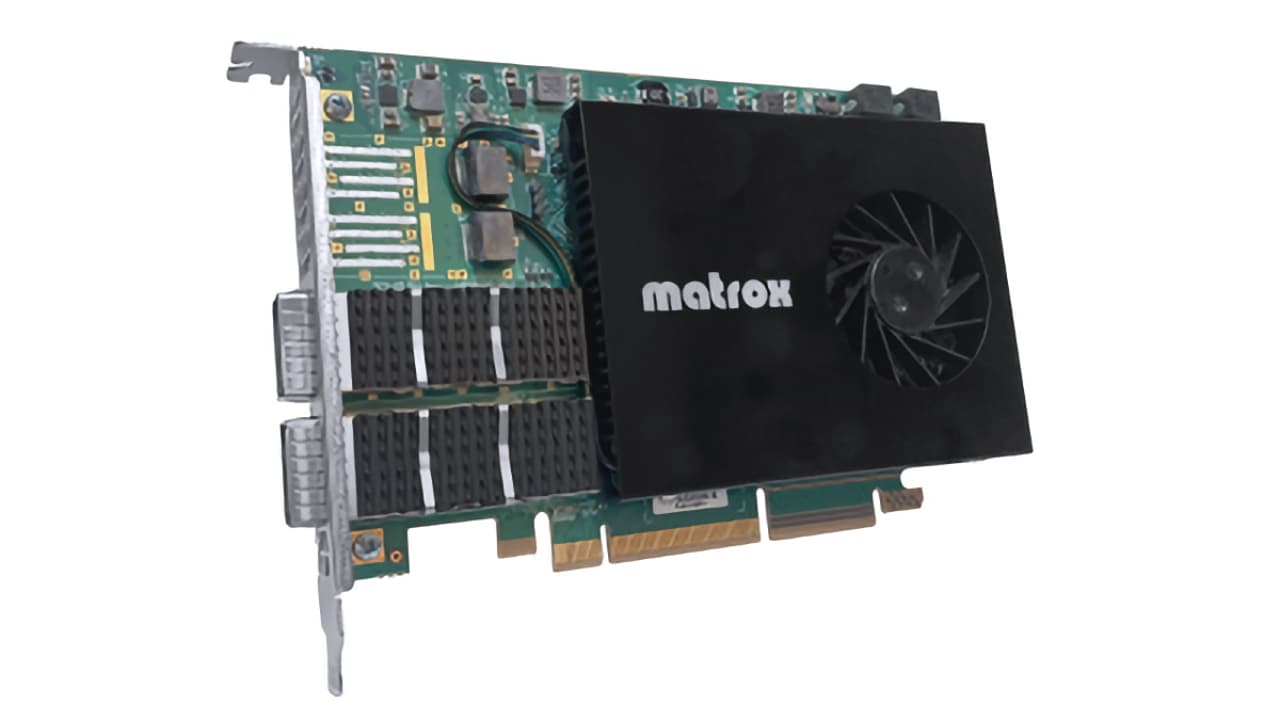
Matrox Video has launched new low-density versions of the Matrox DSX LE5 D25 LP and DSX LE6 D100 network interface controller cards.
Matrox Video says that the new additions to the company’s lineup of SMPTE ST 2110 cards enable flexible, cost-effective design of products supporting the broadcast and Pro AV industries’ accelerating shift to IP workflows.
Architected as video-aware, commercial-off-the-shelf (COTS) ST 2110 NIC cards, like existing ST 2110 cards in the Matrox Video product portfolio, the new cards feature hardware-based PTP to provide nanosecond-range ST 2059-2 accuracy, and they offload all ST 2110 packet processing from the CPU. An ultra-low-latency (ULL) feature minimizes in-to-out latency for multichannel HD, 4K, and 8K applications.
The new Matrox DSX LE6 D100 ST 2110 is designed for high-performance media environments including broadcast and virtual production. Featuring dual QSFP 28 connectors, this PCIe Gen 4 x 8 card offers up to eight channels of UHD@P60 or two channels of 8KP60 input and output, all with ST 2022-7 redundancy. The card has hardware-based PTP to provide nanosecond-range ST 2059-2 accuracy and offloads all ST 2110 packet processing from the CPU, which is essential for high-density and high-resolution applications. This card also offers ultra-low latency to minimize in-to-out latency for multi-channel 4K and 8K applications.
Meanwhile, the new entry-level DSX LE5 D25 LP (low-profile) cards allow compact 1U, 2U, and 3U COTS systems to support lower-density workflows of 1080i/1080p/UHD over a 10/25 GbE interface. One card supports four HD/3G or one 4K/UHD reconfigurable I/O, and the other supports four HD/3G or one 4K/UHD I/O simultaneously.
Also new are the latest updates to the Matrox DSX SDK for both DSX and X.mio NIC and I/O cards, which enable ultra-low latency from in to out, with a 1-frame delay for interlaced video and a 2-frame delay for progressive video. The new “large canvas” feature enabled on X.mio5 ST 2110 cards allows customizable regions of interest from a large canvas to be output as multi-channel 1080P and UHD resolutions for flexible and advanced multi-screen display workflows. DSX SDK 10.5 also supports ST 2110-22 with JPEG-XS encoding and decoding and adds native support for AWS S3 with the Flex Reader and Writer for cloud-based applications.
“The Matrox Video commitment to the SMPTE ST 2110 standard is unquestionable, and by introducing both entry-level and ultra-high-spec ST 2110 NICs right now, we address the growth of the ST 2110 market — at many levels for many applications and productions — across broadcast and Pro AV," said Francesco Scartozzi, vice president of sales and business development, Broadcast and Media Group, at Matrox Video. “Our new ST 2110 NICs use the same robust DSX SDK as our popular DSX LE5 and XMIO5 D25/Q25 NICs, which have been used for years in the 24/7 ST 2110 infrastructures of the most prestigious broadcasters worldwide. The DSX SDK enables complete support of ST 2110 solutions with minimal engineering effort and resources. Because all the complexity of ST 2110 is managed by the SDK, developers handle the video, audio, and ancillary data buffers just as they would with an SDI application.”
Tags: Production NAB 2024 Matrox ST 2110


Comments